I want to share some thoughts on how valuable the current craze in wildlife photography is to conservation, but remind people that it can be a double-edged sword. I remember when I was young and first getting interested in photography that my photos would, for the most part, get placed in bulky photo albums and were seen by only a handful of people. Today I can post images on instagram and Facebook that can be viewed by thousands of people from all over the world in a few days. They can enjoy them and leave comments, and it is fun to get positive feedback and help others appreciate the beautiful landscapes and creatures of the planet. People’s interest in wildlife photography puts a direct value on these animals and resources. This is wonderful thing and although the technology obsession is often blamed for causing a disconnect from nature, it can also have the opposite effect.
I have myself experienced the thrill and monetary success of having my media go viral in the past. While working for the BBC I did very well filming bears with unmanned GoPro cameras. The super-close, ultra wide look was becoming the new sensation in wildlife photography. As long as the animals weren’t baited in, and the cameras didn’t disturb the animals, it didn’t do much harm. I did fear that there could come a point when everyone would be placing remote cameras all over wildlife habitat to achieve similar results, and unfortunately that does happen sometimes. I was criticized by some of my colleagues, and am much more careful now to set good examples to the world.
Below is an example of how our craving for “likes” and positive comments can effect the animals we admire in ways that deserve consideration. These two stunning images of a polar bear in the water are totally amazing, and have gone crazy on instagram. At first glance one is stunned by the composition, and thinks “wow, how did he get that?” I love seeing people get excited about polar bears, as it makes us consider their likely extinction in the future due to climate change. I had a discussion with bear guide colleagues; Drew Hamilton, Justin Gibson, Alex De-vries Magnifico Kurt Johnson and Eddy Savage, who are all considered bear experts and talented guides and photographers. We all know the importance of getting good images, but we also care about bears and ethics above all else.
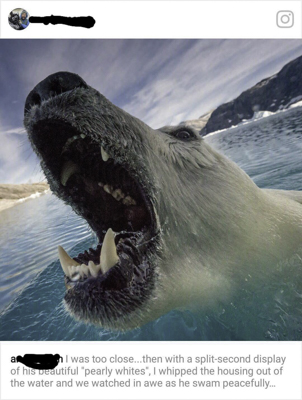
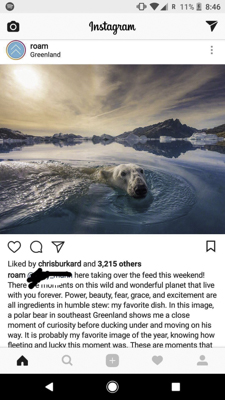
We concluded that these images, taken from a zodiac in the water from a few feet away, were not ethical, and it saddened us to see the explosion of attention they were getting. As bear experts, we know how tremendously stressed out the bear must have been, as it was approached by this craft. We also knew how angry the bear was to have snarled at the camera, and how potentially dangerous this must have been for the photographer. Well the photographer obviously was not hurt, and Im sure the bear recovered from the incident, and now the photographer is reaping the benefits. Obviously other aspiring photographers are seeing these images as the top standard for success. Imagine hundreds of polar bears having their seal hunts ruined, and undergoing tremendous stress by dozens of photographers who chase them around the ice floes in pursuit of “Instagram Fame.” We all contacted the photographer and pleaded our point, and although he didn’t respond for some reason, he did remove the image of the bear snarling at the camera, so it seems he understood our point.
Here is another example. Thousands of people are heart-warmed by this video of a female bear with cubs who climb onto her back. Is this cute? My friends talked about this one as well. This bear and her cubs are totally vulnerable in the water and are terrified by the a boat that approached only feet away. When I am guiding in Alaska and I see a bear swimming I avoid the bear if there are any signs of stress even though I know my clients might get a thrill and some dramatic media if I was to approach her. This is a terribly disturbing video. THUMBS DOWN!!!
Hopefully this post gives everyone a little reason for thought as they browse the ocean of media on the internet. We as social media users are the only ones who can encourage ethical wildlife photography, and spread the word. All wildlife photographers and viewers have some impact on the animals that they love, and over the years I have certainly have, but we need to have boundaries and limits and ethics and know where to draw the line.
What do you guys think?
Brad

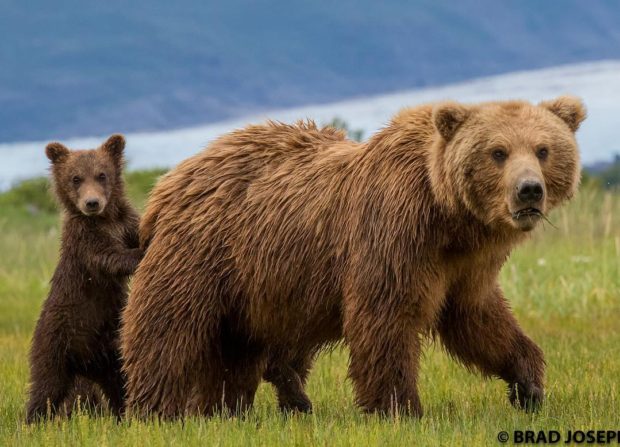

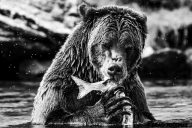
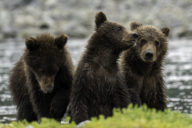
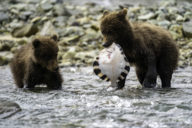
14 Comments
Great article Brad. My concern are also the people that approach wildlife and or do not give them space. Think about the guy in Denali that was killed and partially consumed by the bear he photographed. Amateurs that can’t read bear behavior. I appreciate guides like you and the ones you mentioned.
I will never forget when I was at Swikshak and you and your group were the only ones that moved off the beach and walked in the grass while approaching the whale with bears. It made me so mad that the other men just walked straight toward them, a wall of testosterone that scared the bears away and ruined my experience.
Thanks Brad
hey thanks Tammy! Miss you and hope you are doing well in Homer. I remember when you camped in Swikshak a long time ago! And I remember that happening….
Firstly, there are too many humans at all and, even worse, in-considerate humans — in all relationships — are getting more and more common.
Sadly, although I agree entirely with your article, I doubt if there’s anything that I — even you with your wider audience — can do to slow/stop the “Me-First” generation from damaging nature as well as the rest of we humans
Always wise words from you Fred! I agree
That was me. Brad, haven’t logged in
Hi Brad
I just read your article. I have been in Homer since November and since Clint passed away I will be going home soon to Florida but I had to write and tell you that back in July when I was here taking care of him when the BBC was filming Wild Alaska we were both disgusted on how they were using helicopters to buzz the bears and frightening the moms and cubs.
I also was disgusted with how many bear viewing companies there were now just in Homer. how they have 3 or 4 trips of several people in the same areas of the park and how they are effecting the habitat.
I remember spending the time with Clint and you so many years ago and your ethics with your treatment and love you showed for the bears and other wildlife in the wild. You both taught me what it was to love nature and to protect wildlife and the habitat they lived in.
thank you for still having those values and sharing your journeys with us and thanks for the memories.
Fine article Brad,
Having worked with you in Katami, I have followed your work with wildlife with envy!
Your pictures are an example of your success as a true naturalist, and am looking forward to your next presitation !
Thank you, be safe,
Peter
Thank you for writing about this issue and bringing attention to it. I remember when we were in Hallo Bay and the planes were landing on the beach bringing day trippers. While its great that more people could get out there and experience the bears, chasing the bears off the beach to make it a landing strip is wrong. I appreciated your outlook on guiding and making sure your groups do not disturb the bears from their routines.
More photographers need to speak out about ethics and stop and think about with who and where they spend their money. Game farms for example where you can get that amazing shot of a mountain lion. No one seems to care that the poor lion is then locked in a cage the rest of the day and that 15 min photo shoot was the high point of its day.
Thanks again for bringing the issue up.
Great article Brad, and so true. Agree with everything you said, and I think we have all seen people getting way to close to wildlife. I know I have witnessed it many times over the years in various countries and various species of animals. People usually don’t get it or learn until it is to late and a human is either injured or attacked by the animal that is being crowded and a respectable distance is not being honoured. Then unfortunately it’s not the humans fault but the fault of the animal, and many times that animal pays the price with his/her life because of some idiot human beings actions. So thanks you for this post and giving any one that reads it something to think of, and maybe think of their own actions around wildlife that we all so dearly cherish.
Thanks, Brad. The first step is to raise awareness, and this article does just that. There are those who regrettably will not be moved by concern for the animals, but you do a lot to prevent well meaning people from doing harmful things out of ignorance, including supporting photographers who post dramatic looking images of distressed animals on social media. I very much appreciate your efforts!
Well done! You always raise such important points. Thanks for all you!
Here’s a new question…
What new behaviors are bear species learning long term or short from the constant flow of new human pebbles being dropped into already dynamic, but seemingly still ponds ponds. Since wildlife situations are dynamic and fluid (creating ripples in a still pond), once you place yourself in them (drop your own pebble in the pond to create your own ripples) and the bear species becomes “aware”, how do you know if your ripples are colliding and changing behavior and how can you possibly walk back any of the ripples you have already created? The mere act of repeatedly entering “wild” habitat and making yourself known to the bears makes it no longer wild and therefore the species has changed and will continue to change. It just may not be perceptible to humans yet.
Interesting and a topic I have not spent much time on. Thank you
Great teacher you are Brad with a kindness toward nature that I wish everyone understood.